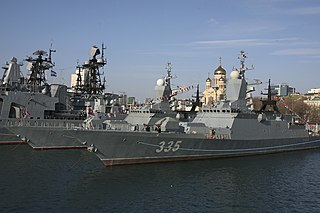
A vertical launching system (VLS) is an advanced system for holding and firing missiles on mobile naval platforms, such as surface ships and submarines. Each vertical launch system consists of a number of cells, which can hold one or more missiles ready for firing. Typically, each cell can hold a number of different types of missiles, allowing the ship flexibility to load the best set for any given mission. Further, when new missiles are developed, they are typically fitted to the existing vertical launch systems of that nation, allowing existing ships to use new types of missiles without expensive rework. When the command is given, the missile flies straight up far enough to clear the cell and the ship, then turns onto the desired course.

The Delhi-class destroyers, also known Project 15 are a class guided-missile destroyers of the Indian Navy. Three ships of this class are in active service. The Delhi-class vessels were the largest vessels to be built in India at the time of their commissioning. The ships were built by Mazagon Dock Limited (MDL) at a cost of ₹750 crore each.

The Tarantul-class corvette, Soviet designation Project 1241 Molniya are a class of Russian missile corvettes.

The Talwar-class frigates or Project 11356 are a class of stealth guided missile frigates designed and built by Russia for the Indian Navy. The Talwar-class guided missile frigates are the improved versions of the Krivak III-class frigates used by the Russian Coast Guard. The design has been further developed as the Admiral Grigorovich-class frigate for the Russian Navy. Six ships were built in two batches between 1999 and 2013.

The Brahmaputra-class frigates are guided-missile frigates of the Indian Navy, designed and built in India. They are an enhancement of the Godavari class, with a displacement of 3850 tons and a length of 126 metres (413 ft). Although of similar hull and dimension, internally, the Brahmaputra and Godavari classes have different configurations, armaments and capabilities. 3 ships of this class serve in the Indian Navy.

INS Tabar (F44) is the third of the Talwar-class frigate of the Indian Navy. The frigate was built by Baltiyskiy Zavod in St. Petersburg, Russia. The frigate was commissioned on 19 April 2004 in Kaliningrad, Russia with Captain Biswajit Dasgupta. As of August 2024, the current Commanding Officer (CO) of INS Tabar is Captain MR Harish.

The People's Liberation Army Navy Surface Force is the surface warfare branch of China's People's Liberation Army Navy (PLAN), consisting of all surface vessels in operational service with the PLAN. The PLAN Surface Force operates 661 ships organized into three fleets: the North Sea Fleet, the East Sea Fleet and the South Sea Fleet.

The Kortik close-in weapon system (CIWS) is a modern naval air defence gun-missile system deployed by the Russian Navy. Its export version is known as Kashtan, with the NATO designation CADS-N-1 Kashtan.

Kora-class corvettes are guided missile corvettes, in active service with the Indian Navy and the National Coast Guard of Mauritius. Four vessels were built at Garden Reach Shipbuilders and Engineers (GRSE) and outfitted at Mazagon Dock Limited (MDL).

INS Trikand (F51) is a Talwar-class frigate of the Indian Navy. She is the third and final ship of the second batch of Talwar-class frigates ordered by the Indian Navy. She was built by the Yantar shipyard in Kaliningrad, Russia. She was commissioned to Indian Navy service on 29 June 2013.

INS Talwar (F40) is the lead ship of the Talwar-class frigates of the Indian Navy. Its name means "Sword" in Hindi. She was built in Russia, and commissioned into the Indian Navy on 18 June 2003.

The Sovremenny class, Soviet designation Project 956 Sarych (buzzard), is a class of anti-ship and anti-aircraft guided-missile destroyers of the Soviet and later Russian Navy. The ships are named after qualities, with "Sovremenny" translating as "modern" or "contemporary". Most of the ships have been retired from active service and one converted into a museum ship in 2018; as of 2021 three remain in commission with the Russian Navy with several in overhaul. Four modified ships were delivered to the People's Liberation Army Navy, and remain in service.

The Visakhapatnam-class destroyers, also classified as the P-15 Bravo class, or simply P-15B, is a class of guided-missile destroyers currently being built for the Indian Navy. The Visakhapatnam class is an upgraded derivative of its predecessor, the Kolkata class, with improved features of stealth, automation and ordnance.

Gromkiy is a Steregushchiy-class corvette of the Russian Navy.

Merkury is a Steregushchiy-class corvette of the Russian Navy. The original name for the corvette was Retiviy prior to 2021.

Geroy Rossiyskoy Federatsii Aldar Tsydenzhapov is a Steregushchiy-class corvette of the Russian Navy.

















